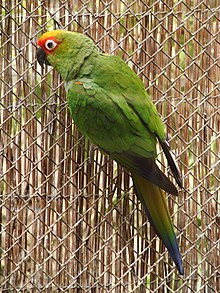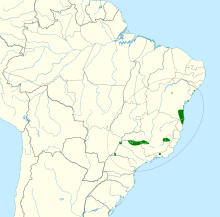311:
42:
405:’s dietary behavior is classified as frugivorous. However, the parakeets have been reported to have other food sources, including seeds, flower petals and buds, nectar, and lichens. During a 2010 to 2012 study on the eating habits of the golden-capped parakeets, the birds were noted to primarily ignore the exocarp and mesocarp or outer layers of the fruits in order to eat the seeds within. Among the food ingested by the parakeets, the researchers observed the parakeets to eat various plant materials from
95:
217:
70:
470:’ small population relatively manages to maintain its numbers. Conservation efforts targeted towards parrots and protection of its habitat have also helped slow the decline, but a continued concern over the possibility of poachers who capture exotic birds as pets and habitat loss to livestock, coffee, sugarcane, and soybean farms keeps the
372:
subspecies, golden-capped parakeets tend to populate their areas of residence within forests in groups, which can range from 4 to 15 individual parakeets. The breeding season occurs during the austral summer, which in the southern hemisphere is from
December to March, with pairs being sighted around
465:
Though observed to be in decline due to deforestation based on data recorded in affected areas, golden-capped parakeets are more commonly found outside primary forests and have a distribution of population throughout Guyana, Brazil, and
Paraguay. During a 2018 published survey of local bird species
393:
inhabits mostly the semi-deciduous forests in northeastern Brazil, although through time it has adapted to rural agricultural areas and sometimes even urban cities, spreading throughout the states of Bahia, Minas Gerais, Espírito Santo, Rio de
Janeiro, São Paolo, Goiás, and Paraná.
466:
in Minas Gerais, Brazil, golden-capped parakeets received an
Occurrence Frequency of “Frequent” throughout the region, and other surveys reporting sightings in the Chapada Diamantina National Park and the Serra de Ouricana have revealed that the
333:
The
Aratinga genus name was created to describe medium to small south American conures and parrots. As such, alongside its common name as the golden-capped parakeet, it is also called the golden-capped conure. Within the
669:
Vitorino, Breno Dias; Rodrigues, Marisa Brandão; Frota, Angélica Vilas Boas da; Avelar, Daniel
Moreira de; Rodrigues, Wellington Luiz; Castrillon, Solange Kimie Ikeda; Nunes, Josué Ribeiro da Silva (2018-04-12).
653:
Silva, Antonio P. and Melo, Celine “Foraging of the Golden-Capped
Parakeet (Aratinga Auricapillus) in the Anthropogenic Landscape in Brazil.” The Neotropical Ornithological Society. 2013.
321:
It is 30 cm (12 in) long and mostly green with a black beak, white eyerings, orange-red belly, and red face fading to yellow over the crown. Juvenile members of the
964:
325:
group develop their yellow head markings and red coloration on the lower body in adulthood. The approximate weight for golden-capped parakeets is 4.9-5.25 oz.
1044:
279:
912:
938:
1054:
636:
A New
Species of Aratinga Parakeet (Psittaciformes: Psittacidae) from Brazil, With Taxonomic Remarks on the Aratinga Solstitialis Complex
360:). Other variables such as size were found to have little variability between the two, and thus the distinction is still under question.
457:
s habitat has led to an increase in the consumption of cultivated exotic seeds and fruits including citruses, papaya, mango, and maize.
275:
593:
1064:
352:. The measured variable for this basis is slightly varied coloration between the two (less red on back and yellow on head for
943:
377:
of around 3 to 5 eggs per nesting; the incubation period for these eggs is estimated to be around 25 days, and young
969:
310:
815:
94:
829:
1059:
977:
298:
is a good biological indicator because of its vulnerability, high detectability as well as its sensitivity to
982:
850:
777:
41:
299:
189:
671:
899:
842:
59:
654:
1069:
574:
Anjos, Luiz dos (June 2007). "Efficiency of the point count method in bird richness evaluation".
224:
89:
1049:
990:
956:
873:
757:
693:
556:
406:
378:
995:
747:
683:
617:
546:
315:
855:
216:
446:
430:
341:
497:
736:"An avifaunal survey of the vanishing montane Atlantic forest of southern Bahia, Brazil"
1021:
422:
1038:
951:
712:
635:
535:"The Importance of Considering Bird Detectability for Assessing Biological Integrity"
506:
374:
206:
79:
74:
17:
734:
Gonzaga, L. P.; Pacheco, J. F.; Bauer, C.; Castiglioni, G. D. A. (September 1995).
336:
291:
878:
865:
672:"Aves de paisagem rural na região Centro-oeste do estado de Minas Gerais, Brasil"
1008:
925:
809:
259:
156:
50:
1016:
752:
735:
340:
species group, the golden-capped parakeet is the only member considered to be
287:
800:
761:
697:
560:
688:
551:
534:
438:
106:
373:
November and dependent young around March. Golden-capped parakeets have a
794:
267:
166:
126:
639:
917:
837:
283:
271:
930:
824:
634:
Luís Fábio
Silveira, Flávio César Thadeo de Lima, Elizabeth Höfling,
263:
255:
146:
116:
891:
771:
453:). In addition, the growing anthropogenic landscape surrounding the
1003:
886:
414:
309:
136:
904:
775:
655:
https://sora.unm.edu/sites/default/files/ON%2024(1)%2055-66.pdf
638:, The Auk, Volume 122, Issue 1, 1 January 2005, Pages 292–305,
491:
489:
487:
381:
take around 7–8 weeks before they are able to take flight.
474:
in the least concern category on the IUCN’s red list.
594:"Golden-capped Parakeet - BirdLife Species Factsheet"
620:. World Parrot Trust (2021). Retrieved 9 March 2021.
784:
533:Bochio, Gabriela Menezes; Anjos, Luiz dos (2012).
713:"Birds of the Chapada Dimantina, Bahia, Brazil"
8:
280:subtropical or tropical moist lowland forest
772:
215:
68:
40:
31:
751:
687:
550:
483:
640:https://doi.org/10.1093/auk/122.1.292
7:
676:Neotropical Biology and Conservation
664:
662:
649:
647:
630:
628:
626:
613:
611:
1045:IUCN Red List least concern species
507:IUCN Red List of Threatened Species
348:is said to contain the subspecies
276:subtropical or tropical dry forest
25:
576:Revista Brasileira de Ornitologia
93:
740:Bird Conservation International
596:. BirdLife International (2008)
496:BirdLife International (2022).
1:
1055:Birds of the Atlantic Forest
582:: 239–243 – via ORCID.
1086:
539:Natureza & Conservação
753:10.1017/s0959270900001040
711:Parrini, Ricardo (1999).
230:
223:
214:
195:
188:
90:Scientific classification
88:
66:
57:
48:
39:
34:
1065:Birds described in 1820
689:10.4013/nbc.2018.131.08
552:10.4322/natcon.2012.012
514:: e.T22685710A209378080
35:Golden-capped parakeet
618:“Golden-capped Conure”
318:
290:. It is threatened by
246:golden-capped parakeet
1022:Aratinga-auricapillus
830:aratinga-auricapillus
816:Aratinga auricapillus
786:Aratinga auricapillus
500:Aratinga auricapillus
472:Aratinga auricapillus
468:Aratinga auricapillus
391:Aratinga auricapillus
370:Aratinga solstitialis
313:
251:Aratinga auricapillus
199:Aratinga auricapillus
300:forest fragmentation
233:Aratinga auricapilla
181:A. auricapillus
18:Golden-capped conure
60:Conservation status
368:As members of the
319:
254:) is a species of
1032:
1031:
991:Open Tree of Life
778:Taxon identifiers
443:Pterogynes nitens
411:Guazuma Ulmifolia
242:
241:
237:
83:
16:(Redirected from
1077:
1025:
1024:
1012:
1011:
999:
998:
986:
985:
973:
972:
960:
959:
947:
946:
934:
933:
921:
920:
908:
907:
895:
894:
882:
881:
869:
868:
859:
858:
846:
845:
843:58CCB2690F43662D
833:
832:
820:
819:
818:
805:
804:
803:
773:
766:
765:
755:
746:(2–3): 279–290.
731:
725:
724:
708:
702:
701:
691:
666:
657:
651:
642:
632:
621:
615:
606:
605:
603:
601:
590:
584:
583:
571:
565:
564:
554:
530:
524:
523:
521:
519:
493:
455:A. auricapillus’
447:chinaberry trees
423:silk floss trees
407:West Indian Elms
316:Jurong Bird Park
235:
219:
201:
98:
97:
77:
72:
71:
44:
32:
21:
1085:
1084:
1080:
1079:
1078:
1076:
1075:
1074:
1060:Birds of Brazil
1035:
1034:
1033:
1028:
1020:
1015:
1007:
1002:
994:
989:
981:
976:
968:
963:
955:
950:
942:
937:
929:
924:
916:
911:
903:
898:
890:
885:
877:
872:
864:
862:
854:
849:
841:
836:
828:
823:
814:
813:
808:
799:
798:
793:
780:
770:
769:
733:
732:
728:
710:
709:
705:
668:
667:
660:
652:
645:
633:
624:
616:
609:
599:
597:
592:
591:
587:
573:
572:
568:
532:
531:
527:
517:
515:
495:
494:
485:
480:
463:
451:Melia azedarach
435:Psidium guajava
403:A. auricapillus
400:
387:
366:
358:A. auricapillus
354:A. a. aurifrons
350:A. a. aurifrons
346:A. auricapillus
337:A. solstitialis
331:
323:A. auricapillus
308:
296:A. auricapillus
210:
203:
197:
184:
92:
84:
73:
69:
62:
28:
27:Species of bird
23:
22:
15:
12:
11:
5:
1083:
1081:
1073:
1072:
1067:
1062:
1057:
1052:
1047:
1037:
1036:
1030:
1029:
1027:
1026:
1013:
1000:
987:
974:
961:
948:
935:
922:
909:
896:
883:
870:
860:
847:
834:
821:
806:
790:
788:
782:
781:
776:
768:
767:
726:
703:
658:
643:
622:
607:
585:
566:
525:
482:
481:
479:
476:
462:
459:
427:Ceiba speciosa
399:
396:
386:
383:
365:
362:
330:
327:
307:
304:
270:. Its natural
258:in the family
240:
239:
228:
227:
221:
220:
212:
211:
204:
193:
192:
186:
185:
178:
176:
172:
171:
164:
160:
159:
154:
150:
149:
147:Psittaciformes
144:
140:
139:
134:
130:
129:
124:
120:
119:
114:
110:
109:
104:
100:
99:
86:
85:
67:
64:
63:
58:
55:
54:
46:
45:
37:
36:
26:
24:
14:
13:
10:
9:
6:
4:
3:
2:
1082:
1071:
1068:
1066:
1063:
1061:
1058:
1056:
1053:
1051:
1048:
1046:
1043:
1042:
1040:
1023:
1018:
1014:
1010:
1005:
1001:
997:
992:
988:
984:
979:
975:
971:
966:
962:
958:
953:
949:
945:
940:
936:
932:
927:
923:
919:
914:
910:
906:
901:
897:
893:
888:
884:
880:
875:
871:
867:
861:
857:
852:
848:
844:
839:
835:
831:
826:
822:
817:
811:
807:
802:
796:
792:
791:
789:
787:
783:
779:
774:
763:
759:
754:
749:
745:
741:
737:
730:
727:
722:
718:
714:
707:
704:
699:
695:
690:
685:
681:
677:
673:
665:
663:
659:
656:
650:
648:
644:
641:
637:
631:
629:
627:
623:
619:
614:
612:
608:
595:
589:
586:
581:
577:
570:
567:
562:
558:
553:
548:
544:
540:
536:
529:
526:
513:
509:
508:
503:
501:
492:
490:
488:
484:
477:
475:
473:
469:
460:
458:
456:
452:
448:
444:
440:
436:
432:
431:common guavas
428:
424:
420:
416:
412:
408:
404:
397:
395:
392:
384:
382:
380:
376:
371:
363:
361:
359:
356:than that of
355:
351:
347:
343:
339:
338:
328:
326:
324:
317:
312:
305:
303:
301:
297:
293:
289:
285:
281:
277:
273:
269:
265:
261:
257:
253:
252:
247:
238:
234:
229:
226:
222:
218:
213:
208:
202:
200:
194:
191:
190:Binomial name
187:
183:
182:
177:
174:
173:
170:
169:
165:
162:
161:
158:
155:
152:
151:
148:
145:
142:
141:
138:
135:
132:
131:
128:
125:
122:
121:
118:
115:
112:
111:
108:
105:
102:
101:
96:
91:
87:
81:
76:
75:Least Concern
65:
61:
56:
52:
47:
43:
38:
33:
30:
19:
785:
743:
739:
729:
720:
716:
706:
682:(1): 62–73.
679:
675:
598:. Retrieved
588:
579:
575:
569:
545:(1): 72–76.
542:
538:
528:
516:. Retrieved
511:
505:
499:
471:
467:
464:
454:
450:
442:
434:
426:
418:
410:
402:
401:
390:
388:
369:
367:
357:
353:
349:
345:
335:
332:
322:
320:
295:
292:habitat loss
250:
249:
245:
243:
236:(Kuhl, 1820)
232:
231:
198:
196:
180:
179:
167:
29:
978:Neotropical
926:iNaturalist
810:Wikispecies
375:clutch size
306:Description
288:plantations
260:Psittacidae
157:Psittacidae
51:Wroclaw Zoo
1039:Categories
1017:Xeno-canto
478:References
439:pterogynes
379:fledglings
1070:Parakeets
762:0959-2709
698:2236-3777
600:3 January
561:1679-0073
342:polytypic
262:found in
175:Species:
113:Kingdom:
107:Eukaryota
53:, Poland
1050:Aratinga
1004:Species+
957:22685710
856:22685710
851:BirdLife
795:Wikidata
723:: 86–95.
717:Continga
419:Zea mays
364:Behavior
329:Taxonomy
272:habitats
268:Paraguay
225:Synonyms
168:Aratinga
153:Family:
127:Chordata
123:Phylum:
117:Animalia
103:Domain:
80:IUCN 3.1
996:1034560
983:gocpar2
918:2479097
892:gocpar2
866:gocpar2
838:Avibase
801:Q303744
518:22 July
445:), and
385:Habitat
284:savanna
209:, 1820)
163:Genus:
143:Order:
133:Class:
78: (
970:867384
944:714044
905:311759
825:ARKive
760:
696:
559:
461:Status
294:. The
286:, and
282:, dry
264:Brazil
256:parrot
931:72522
887:eBird
863:BOW:
415:maize
1009:9191
965:NCBI
952:IUCN
939:ITIS
913:GBIF
879:G65D
758:ISSN
694:ISSN
602:2009
557:ISSN
520:2022
512:2022
398:Diet
389:The
274:are
266:and
244:The
207:Kuhl
137:Aves
900:EoL
874:CoL
748:doi
684:doi
547:doi
437:),
429:),
421:),
413:),
314:At
49:At
1041::
1019::
1006::
993::
980::
967::
954::
941::
928::
915::
902::
889::
876::
853::
840::
827::
812::
797::
756:.
742:.
738:.
721:11
719:.
715:.
692:.
680:13
678:.
674:.
661:^
646:^
625:^
610:^
580:15
578:.
555:.
543:10
541:.
537:.
510:.
504:.
486:^
344::
302:.
278:,
764:.
750::
744:5
700:.
686::
604:.
563:.
549::
522:.
502:"
498:"
449:(
441:(
433:(
425:(
417:(
409:(
248:(
205:(
82:)
20:)
Text is available under the Creative Commons Attribution-ShareAlike License. Additional terms may apply.

